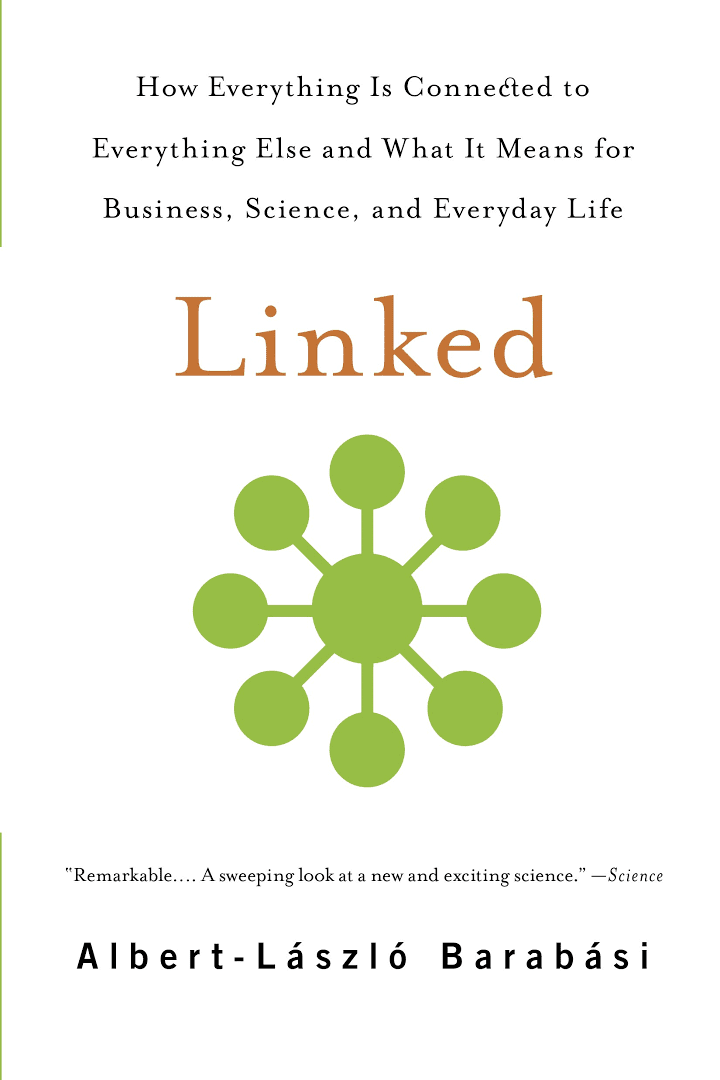7.8 /10 1 Votes7.8
Country United States Publication date May 14, 2002 Pages 280 Originally published 14 May 2002 Page count 280 ISBN 0738206679 | 3.9/5 Goodreads Language English Followed by Bursts (2010) | |||||||||||||||||||||||||||||||||
 | ||||||||||||||||||||||||||||||||||
Similar Albert-László Barabási books, Popular science books, Systems theory books | ||||||||||||||||||||||||||||||||||
Linked: The New Science of Networks is a popular science book written by the Hungarian physicist Albert-László Barabási and first published by the Perseus Books Group in 2002.
Contents
Barabási has changed the way of thinking about real-world networks and largely contributed to making networks the revolutionary science of the 21st century. Linked is his first book that introduces the highly developed field of Network Science to a broad audience. Linked has become a bestseller with more than 70,000 copies sold after fourteen printings and it was selected as one of the Best Business Books in 2002.
Synopsis
The main purpose of Linked is to introduce the science of networks to the general audience. It provides an easy and readable introduction to the main models and properties of networks and their applications in many areas of real life, such as the spread of epidemics, fighting against terrorism, handling economic crises or solving social problems of the society. As the subtitle of the book says Linked reveals 'How Everything is Connected to Everything Else and What It Means for Business, Science, and Everyday Life'.
As Barabási writes in the Introduction, Linked '…has a simple aim: to get you to think networks. It is about how networks emerge, what they look like, and how they evolve. It shows you a Web-based view of nature, society, and business, a new framework for understanding issues ranging from democracy on the Web to the vulnerability of the Internet and the spread of deadly viruses. Networks are present everywhere. All we need is an eye for them.'
Contents
Linked contains fifteen chapters (named links) that introduce different concepts and applications of networks:
Reactions
Sidney Redner, leading physicist of Boston University, describes Linked In Nature as an entertaining introductory level book of modern science. He writes “His enthusiasm is apparent throughout the narrative, a feature that makes for good reading. … I would enthusiastically recommend them to my own family members. It is remarkable and gratifying to see excellent popularizations of a burgeoning field of scientific research while many developments are still in progress.”
Ian Foster reviews Linked for Science: “…I found both books [Linked and Mark Buchanan’s Nexus] wonderfully revealing and thought provoking in terms of the broad relevance of the ideas and their future implications.”
A review by James Brody in Human Nature Review says: “Linked offers many heuristic possibilities if your interests are in genetic, neural, electronic, or social organizations. Much of the existing literature marvels at the beauty of complex organizations but doesn't take us past awe and eye candy. Yes, emergence exists but by what rules? Barabasi describes simple rules that may have tremendous power.”
New York Times business journalist William J. Holstein says: “Once you understand that concept, you're off on an intellectual detective journey. Professor Barabasi has invented a vocabulary to talk about the structure of networks.”
Blogcritics.org writes: “The joy of Albert-László Barabási's book, Linked: The New Science of Networks is that, after reading it, you can't look anywhere without seeing networks. … Buy the book. How often do you get a chance to radically alter your vision for less than $20?”
